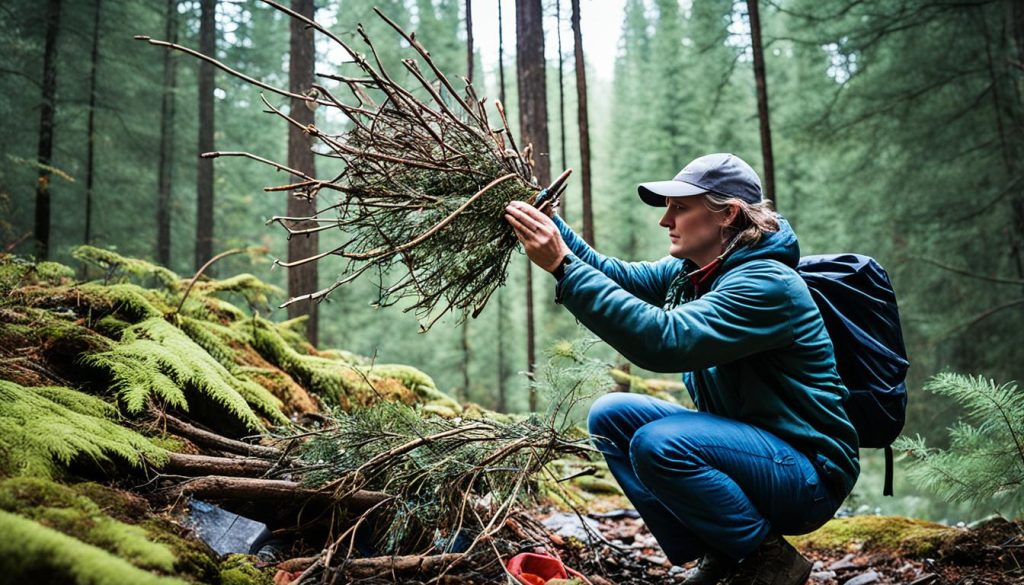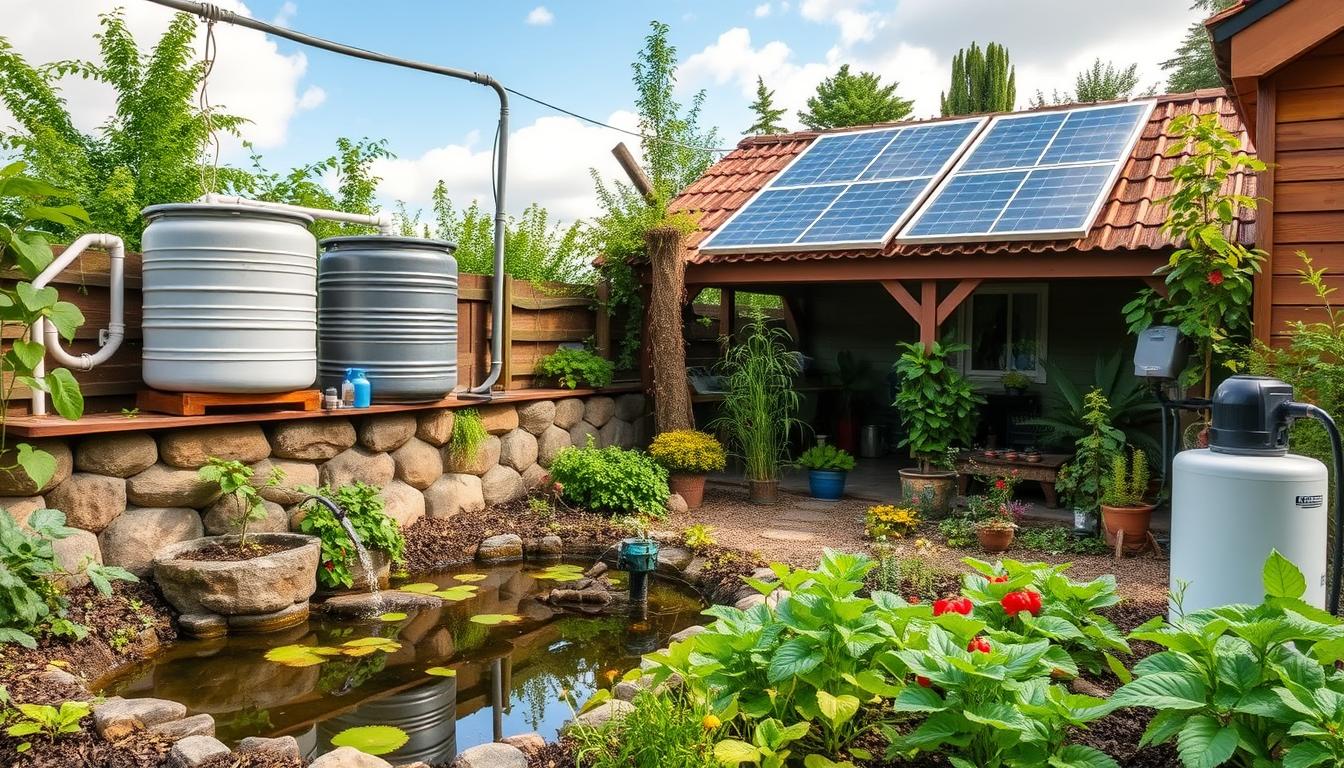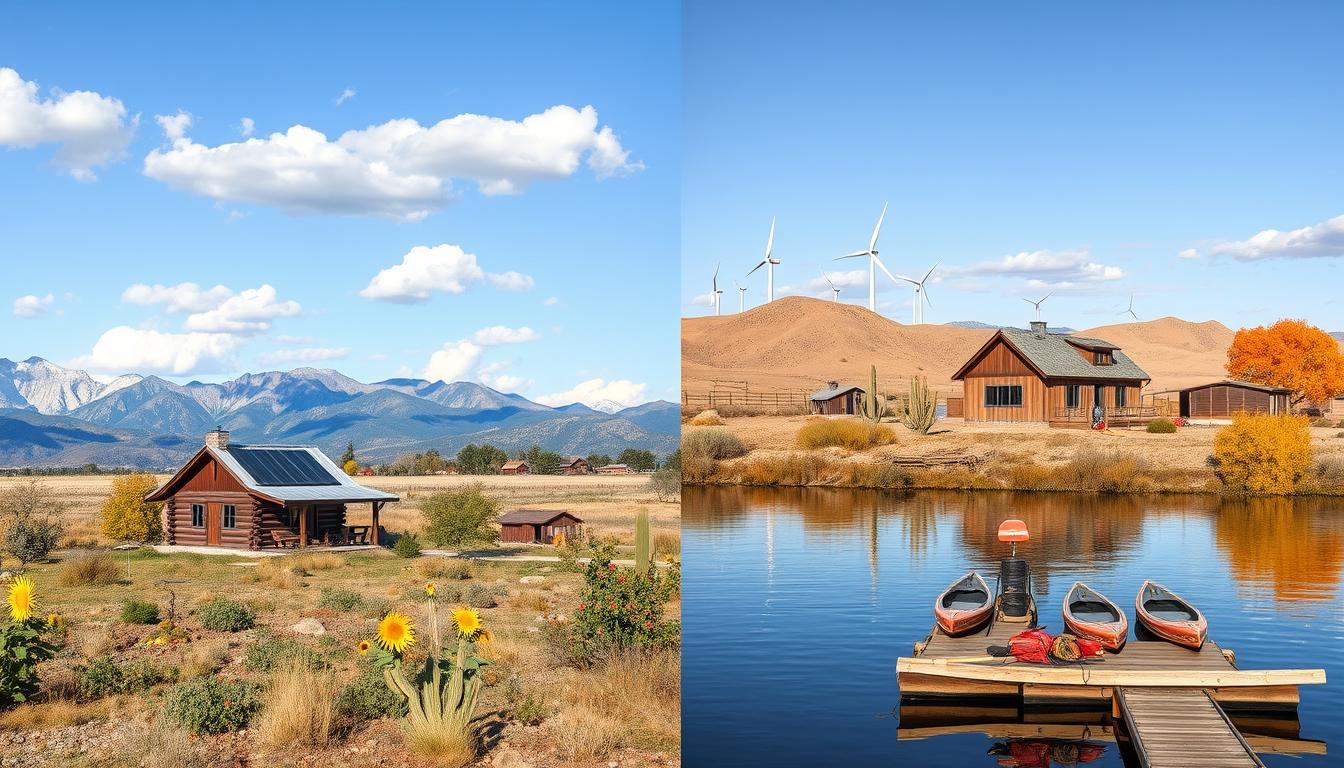Going into the great outdoors can be thrilling and fulfilling, but it also has risks. As a beginner, learning key survival skills is key to staying safe and ready for tough situations in the wild. This guide will show you 12 important survival techniques every newbie should learn before heading out.
Skills like building a fire, making clean water, finding food, building shelters, and signaling for help are essential. These basics will give you the skills and confidence to handle the wilderness. By practicing these in a safe place, like your backyard, you’ll be ready for emergencies and more likely to survive if needed.
Key Takeaways
- Mastering essential survival skills is crucial for beginner outdoor enthusiasts.
- This article covers 12 vital techniques, including fire-building, water purification, foraging, and shelter construction.
- Practicing these skills in a safe, controlled environment can boost confidence and preparedness for real-world emergencies.
- Acquiring these beginner survival skills can significantly improve your chances of making it through challenging situations in the wilderness.
- Becoming a skilled beginner prepper can provide peace of mind and a sense of security when venturing into the great outdoors.
Introduction
Survival skills are key for anyone going into the wild, whether you’re a pro or a newbie. These skills can save your life in an emergency. It’s vital to understand the importance of survival skills and learn the core survival skills overview. This knowledge keeps you safe and ready for the wilderness.
Importance of Survival Skills for Beginners
Survival skills help you handle tough environments, find food and water, and build shelter. They’re especially important for beginners. Learning these skills boosts your confidence and lowers the risk of getting hurt or sick. This makes your outdoor adventures more enjoyable and fulfilling.
Overview of Essential Survival Skills
This article covers 12 key survival skills for beginners. These include:
- Building a fire
- Creating potable water
- Foraging for food
- Identifying edible plants and avoiding poisonous ones
- Tying essential knots
- Constructing survival weapons, such as slingshots
- Building a shelter
- Administering basic first aid
- Trapping small game and survival fishing
- Signaling for help
- Developing the right mindset for outdoor survival
- And more
Learning these survival skills prepares beginners for outdoor challenges. It ensures a safer and more rewarding adventure.
Building a Fire
Starting a fire is key for survival. It keeps you warm, cooks food, purifies water, and keeps predators away. To build a fire, you need the right tinder materials. You can use dry tinder like cotton balls and birch bark, or go for feather sticks and amadou fungus for something different.
Finding and Preparing Tinder Materials
To start a fire, you need good tinder. Here are some great options:
- Dry tinder, such as cotton balls, dryer lint, or shredded newspaper
- Fibrous materials like birch bark, cedar shavings, or dead grass
- Feather sticks, created by carving thin, curled shavings into a piece of wood
- Amadou fungus, a spongy, fire-resistant material found on certain trees
Make sure your tinder is dry and free of moisture. This makes it easier to light.
Techniques for Starting a Fire Without Matches
Once you have tinder, you need a way to light it. While matches are easy, there are other ways to start a fire:
- Flint and steel: Strike a piece of flint against a steel striker to make sparks that can light your tinder.
- Bow drill: Use a wooden spindle and a bow to create friction and heat, starting a fire.
- Hand drill: Like the bow drill, but use your hands to spin the spindle and make heat.
Learning these methods takes time, but it’s worth it. Being able to start a fire without matches is a big survival advantage.
“The ability to create fire is one of the most important skills a person can have in a survival situation.”
Creating Potable Water
Having clean, drinkable water is key in outdoor adventures. We’ll look at two ways to purify water: boiling and filtering.
Boiling and Filtering Water
Boiling water is a simple way to make it safe to drink. Just boil it for at least 1 minute to kill harmful germs. This is great when you’re not sure about the water’s cleanliness.
Filtering water is another good option. Use natural materials like charcoal, sand, and rocks to create a filter. This can help remove dirt and make the water safe to drink. It’s useful when boiling isn’t possible.
Building a Solar Still
In dry places, a solar still can be very helpful. It uses the sun to pull water from the ground. This makes it a reliable way to get water purification.
To make a solar still, dig a hole and cover it with a plastic sheet. Put a container in the middle to collect the water. This method uses evaporation and condensation to give you clean water.
“Having the ability to produce clean water in a survival situation can be the difference between life and death.”
Boiling, filtering, or making a solar still are important skills for survival. They help you get the vital water you need to stay alive in the wild.
Foraging for Food
In a survival situation, foraging for edible wild plants can save lives. These plants are full of nutrients and can give you the energy you need when food is hard to find. From the bright stinging nettle to the simple dandelion, the wild is full of plants that are safe to eat.
Lamb’s quarters, also known as wild spinach, grows in many places. Its young leaves and shoots are full of vitamins and minerals. Miner’s lettuce is another wild green that grows in shady, moist spots. It adds a fresh taste to your survival meals.
“Foraging for edible wild plants is a skill that can mean the difference between life and death in a survival situation. With the right knowledge and caution, the wilderness can become a bountiful pantry.”
But, not all plants are safe to eat. It’s important to know which ones are okay to eat and which ones aren’t. Learning to tell edible plants from poisonous ones is crucial for safe foraging.
- Stinging nettle
- Dandelion
- Lamb’s quarters
- Miner’s lettuce
Learning to forage for wild plants is a key survival skill. It can give you a reliable source of food in tough times. With good plant identification skills and respect for nature, you can find and enjoy the wild’s hidden food treasures. This can greatly improve your chances of survival.
Survival skills for beginners
Foraging for food in the wild can be exciting and rewarding, but it’s also risky. Many wild plants look like they’re safe to eat but aren’t. That’s why identifying edible plants and avoiding poisonous ones is key for beginners.
Identifying Edible Plants
Not all wild plants are safe to eat. To forage safely, learn about the look and growth of edible plants. Look for plants with:
- Broad, serrated leaves
- Clusters of small, white flowers
- Thick, sturdy stems
- Berries that are firm and vibrant in color
Also, check where the plant grows. Edible plants often like sunny, well-drained spots. With practice, you’ll get good at spotting nutritious and delicious wild plants.
Avoiding Poisonous Species
Some wild plants are harmful if eaten. Poisonous species can look a lot like safe plants. Watch out for:
- Plants with glossy, waxy leaves
- Flowers that are large and brightly colored
- Berries that are dull in color or have a milky sap
- Leaves or stems that smell bad
Eating poisonous plants can make you very sick or even kill you. So, always be careful and safe when foraging.
“The key to successful foraging is knowing which plants are safe to eat and which to avoid. Careful observation and research are essential for staying alive in the wild.”
Tying Knots
In the world of outdoor survival, learning to tie knots is a key skill. It helps you make important tools like shelters, snares, and fishing lines. This guide will teach you essential knots for survival and how to practice and improve your knot-tying techniques.
Essential Knots for Survival Situations
For survival, every beginner should know a few key knots. These include:
- Bowline: A versatile knot that can be used to tie a loop at the end of a rope, perfect for constructing shelters or securing gear.
- Clove Hitch: A simple yet strong knot that can be used to attach a rope to a tree or post, making it ideal for creating makeshift shelters or tying down equipment.
- Sheet Bend: A knot that can be used to join two ropes of different diameters, a valuable skill for tasks such as building fishing lines or repairing damaged equipment.
Practicing Knot-Tying Techniques
Learning to tie knots takes practice, but it’s doable with patience and effort. Begin with the basic knots on a rope or cord, then move on to more complex knot-tying techniques. Online tutorials and resources can also help improve your skills.
“Knot-tying is a fundamental survival skill that can make the difference between success and failure in the wilderness.”
By spending time learning and practicing tying knots, you’ll become a more confident outdoor enthusiast. Remember, knowing how to tie secure knots is crucial in survival situations. It’s a skill worth mastering.
Making Survival Weapons
In a survival situation, having a reliable self-defense weapon is key. A slingshot is a versatile and easy-to-make option. It can be made from a forked stick, rubber tubing, and leather or canvas. This tool is great for hunting small game or keeping away unwanted visitors.
Constructing a Slingshot
To make a simple yet effective slingshot, you’ll need:
- A sturdy forked stick or branch
- Rubber tubing or strips cut from a tire inner tube
- Leather or canvas for the pouch
- Twine or fishing line for securing the components
First, pick a forked stick that feels good in your hand. Then, attach the rubber tubing to the stick’s ends with twine or fishing line. Next, make a pouch from leather or canvas and attach it between the tubing ends. Your slingshot is now ready to use!
Practicing Aim and Accuracy
Getting good at using a slingshot takes practice, but it’s crucial for survival. Start by aiming at big objects close by, then move back as you get better. Keep an eye on wind, distance, and how your projectiles move to improve your aim.
“Consistent practice is the key to becoming a skilled slingshot marksman. Take the time to hone your technique, and you’ll be able to reliably hit your targets when it counts.”
Remember, a slingshot can be a lifesaver, but use it wisely and ethically. Always respect the power of your survival weapons and keep safety first.
Building a Shelter
Building a strong shelter is key to surviving outdoors. It keeps you safe from the weather and helps keep your body warm. When picking a spot for your shelter, think about how close it is to water, which way the wind blows, and any dangers nearby.
Choosing the Right Location
Find a shelter spot near water but not in flood zones. It should be in a place where the wind won’t bother you. Look for high ground to stay dry and choose a spot with natural protection like caves or thick trees.
Using Natural Materials for Shelter Construction
Use the materials around you to build a strong and warm shelter. Collect branches, leaves, and rocks for a solid base and insulation. Building with nature’s resources can give you the protection you need when you’re lost.

“The ability to construct a safe and comfortable shelter is a fundamental survival skill that can mean the difference between life and death in a wilderness emergency.”
By picking the right spot and using natural materials, you can make a shelter that keeps you safe and sound outside.
Basic First Aid
Being stranded in the wilderness means you might not have easy access to medical help. That’s why knowing basic first aid is key. This part will teach you how to handle common injuries and illnesses in survival situations. It also covers keeping a cool head in emergencies.
Treating Common Injuries and Illnesses
In a survival situation, you could face many medical issues. These include stopping bleeding, treating burns, and fixing broken bones. Knowing how to deal with these injuries is crucial for quick and right action. Learning these first aid basics can help you handle surprises and boost your chances of success.
Staying Calm and Focused in Emergencies
When you’re in a medical emergency outdoors, staying calm and focused is vital. Panic can lead to bad choices and more problems. So, breathe deeply, think clearly, and act with confidence. This way, you can give the right emergency preparedness and care your situation needs.
“The greatest weapon against stress is our ability to choose one thought over another.” – William James
Your knowledge and calm can be your strongest tools in survival. Spending time on learning basic first aid and stress management can really help when it counts.
Fishing and Trapping
In a survival situation, getting protein-rich food is key to staying energized and hopeful. This part looks at two key ways to get food: survival fishing and setting snares for small game.
Setting Snares for Small Game
Trapping small animals like rabbits or squirrels can be a steady way to get protein when other food is hard to find. Here’s how to set snares:
- Look for places where small animals often go, like paths or spots to drink.
- Make a simple snare loop with things like vines, cordage, or flexible branches.
- Put the snare in a way that catches the animal’s head or neck, making sure it’s quick and humane.
- Hide the snare with leaves, twigs, or other things to keep it from being seen.
Survival Fishing Techniques
For survival fishing, there are ways to catch fish without special gear:
- Twig Hooks: Make simple fishing hooks from strong twigs or thorns, and use cordage or plant fibers for the line.
- Fish Traps: Build basic traps with woven branches or reeds to catch fish in shallow water or tidal areas.
- Net Fishing: Make a fishing net from natural stuff like vines, grasses, or even your clothes to throw into the water.
Learning these survival fishing and setting snares methods lets you get protein-rich food easily. This helps you stay healthy in a wilderness emergency.
“In a survival situation, the ability to procure food can mean the difference between life and death.”
Signaling for Help
In a survival situation, knowing how to signal for help can be a lifesaver. Learning how to signal can really boost your chances of getting rescued. We’ll look at two main ways to get the attention of rescuers: fire and smoke signals, and ground-to-air signals.
Using Fire and Smoke Signals
Being able to make a good signaling fire is key for anyone who spends time outdoors. Build a big, bright fire to act as a visual signal that can be seen far away. To make your fire more visible, add green plants or wet stuff to create thick smoke. This smoke signal works well during the day when a regular fire might be hard to see.
Ground-to-Air Emergency Signals
Aside from fire and smoke, you can also make signals on the ground that can be seen from the air. Use rocks, branches, or other natural stuff to make big, clear patterns. Symbols like the “SOS” distress signal, an “X”, or an arrow pointing to where you are can be used for this.
Learning how to signal for help is a vital survival skill. It can greatly increase your chances of getting rescued in an emergency. By knowing and practicing these methods, you can be more prepared and might even save lives.
“The ability to signal for help is a fundamental survival skill that can mean the difference between life and death in an emergency situation.”
Outdoor Survival Mindset
Surviving outdoors is more than just knowing how to do things. Having the right mindset is key to staying alive. We’ll look at ways to beat fear and panic, and how to keep a positive outlook in tough times.
Overcoming Fear and Panic
It’s normal to feel scared and panicked when things get dangerous. But these feelings can make it hard to think clearly. To fight them, try deep breathing exercises, mental visualization techniques, and self-affirmations. Staying calm helps you think clearly and make good choices to stay safe.
Staying Positive and Motivated
Keeping a positive mindset is key to doing well in tough situations. You can do this with gratitude practices, goal-setting, and positive self-talk. Your mental state affects your health and how you make decisions.
“The greatest weapon against stress is our ability to choose one thought over another.” – William James
By focusing on overcoming fear and staying positive, you’ll be more likely to not just survive, but also do well in the outdoors.

Conclusion
Learning survival skills is more than just a useful skill. It builds confidence and prepares you for outdoor adventures. By practicing skills like building fires, purifying water, foraging, and making shelters safely, you’re ready for emergencies or getting lost outdoors.
It’s not just about knowing how to do things. It’s about practicing and improving these skills. With hard work and a desire to learn, you can become skilled in surviving outdoors. You’ll be ready for any challenge that comes your way.
Survival skills help you stay strong, not just physically. They teach you to stay calm, focused, and hopeful in tough times. This helps you get through hard situations and come out stronger. So, start learning survival skills and open up a world of self-reliance, adventure, and growth.







